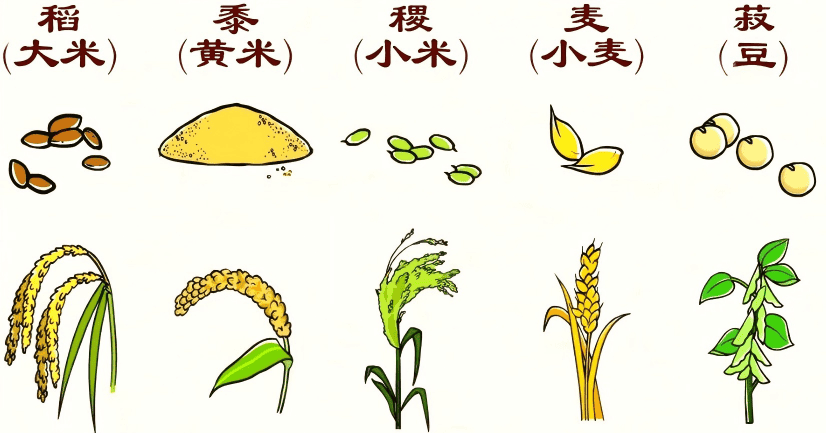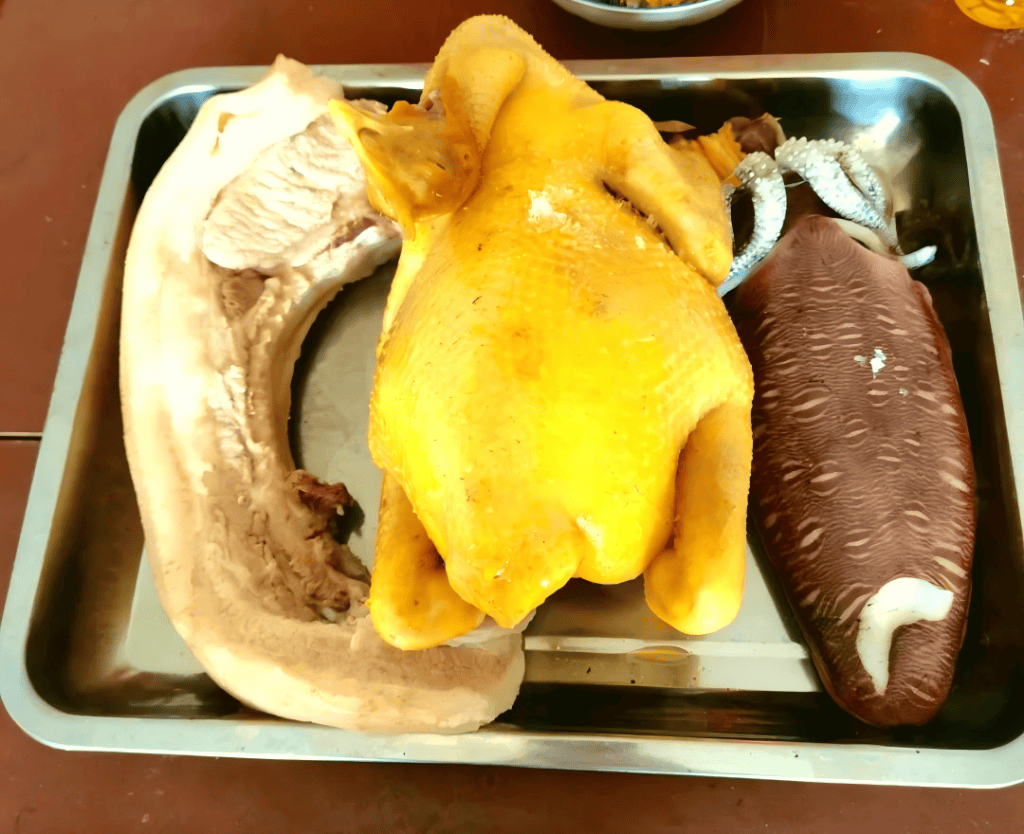Ancient China was an agricultural society. Most families made their livings from farming. Good weather and good harvests every year were the wishes of the Chinese.
Therefore, related sacrificial activities were also born from agricultural activities. To this day, these ancient customs are still intact in Teochew.
Teochew’s “Five Grains Mother”
Every year on the 15th day of the sixth lunar month and the 15th day of the tenth lunar month, the Five Grains Mother’s birthday on the lunar calendar is the day to worship the Five Grains Mother (that is, Shennong).
The Five Grains Mother is not picky. He doesn’t mind eating the simple food of the farmers. He also protects the farmers and worships them wherever the dining table is.
Why use He as a demonstrative pronoun for a mother?
The Five Grains Mother is Shennong
The Five Grains Mother is also known as the Five Grains Emperor and the Five Grains God. He is the Shennong Emperor.
Although the word “mother” is used, the legend is that the Five Grains Mother (Shennong) is a man, and adding the word “mother” means the source of the five grains.
Because he taught people to grow the five grains (in ancient times, it referred to the five grain crops of “rice, millet, sorghum, wheat, and beans”, and later extended to the synonym of grain), he was called the Five Grains Mother.
Details of the worship of the Mother of Five Grains

According to the old folk custom of the Han nationality, the 15th day of the sixth lunar month and the 15th day of the tenth lunar month are the times for worshiping the Mother of Five Grains.
After the early and late rice harvests, farmers fill rice drums with white rice. The drum mouth is sealed with red paper for inserting incense and candles. It is considered the incense burner of the “Mother of Five Grains”.
People also hang images of the “Mother of Five Grains” for worship.
Worshipped during the ‘division of family’ and happy events
In addition to these two days, whenever brothers ‘分家'(“divide the family”,The brothers divided their family’s property and lived independently.It is a peaceful and necessary process for Teochew men ), they must worship the Mother of Five Grains on that day, indicating that they will start a new family from now on.
Pray to the Mother of Five Grains for a good harvest and longevity.
When there are happy events at home, such as:
moving into a new home, getting married, parades and competitions,
the Mother of Five Grains must also be worshipped.
Many people will misunderstand these customs of Teochew as superstition. In fact, the worship of the “Mother of Five Grains” by the Teochew people is a cultural mentality of gratitude.
“Early rice” and “late rice”
“Early rice” and “late rice” are distinguished according to the planting and harvesting seasons of rice.
Referring to two seasons of rice planted and harvested in the same rice field in a year.
Early rice is rice with an earlier sowing period and an earlier maturity period.
While late rice is rice with a later sowing period and a later maturity period.
Early rice:
Usually refers to rice sown in early spring and harvested in summer.
In areas with two crops a year, early rice is the first season of rice, laying the foundation for the annual output.
The growing period of early rice is relatively short, about 90-120 days.
The quality of early rice may be slightly inferior to that of late rice, and some areas will use it as industrial grain or reserve grain.
Late rice:
Usually refers to rice sown in summer and harvested in autumn.
In areas with two crops a year, late rice is the second season of rice, which is a supplement to early rice.
The growing period of late rice is relatively long, about 120-170 days.
The yield and quality of late rice are usually high, and it is the main source of food.
Offerings
Farmers’ Offerings :
Millet Ear Kueh
In addition to the three or five sacrificial animals, fruits and vegetables, the offerings also include “Millet Ear Kueh”. “Millet Ear Kueh” is made of rice flour and peanuts in the shape of The bamboo pole.
People in Chenghai, Shantou, also use rice flour as the stuffing skin.And glutinous rice mixed with white sugar and white sesame as the stuffing to make “Sharp shoulder pole Kueh” in the shape of a shoulder pole for carrying straw.
What is ‘The three or five sacrificial animals’?
The three or five sacrificial animals are offerings used in Chinese sacrificial activities. Mainly refers to livestock.
Among them, “The three sacrificial animals” usually refers to pork, whole chicken, whole fish (or whole duck).
And “The five sacrificial animals” is based on the three animals, adding whole duck (or fish) and shrimp roe (or pig stomach, pig liver and other internal organs).

The three sacrificial animals:
Composition: usually pork (whole pig or pig head), whole chicken, whole fish (or whole duck).
Purpose: Mainly used to worship gods who are closer to civilians, such as Tudigong (the god guarding a village), Mazu, Wangye, etc., as well as worship ancestors.
Placement on the altar: Usually pork is in the middle, chicken is placed on the left, and fish is placed on the right.
Meaning: In traditional customs, when worshiping gods, the sacrificial offerings are usually half-cooked to express the alienation of the relationship between people and gods and the fear of gods.
When worshipping ancestors, the animals will be cooked to show the closeness to the ancestors.
The five sacrificial animals:
Composition:
Pork (whole pig or pig head), whole chicken, whole duck, whole fish, shrimp roe (or pig stomach, pig liver and other internal organs).
Purpose:
Mainly used to worship the Jade Emperor, the Three Officials and other noble gods, and also used in weddings, funerals, vows and other occasions.
Placement on the altar:
Pork in the middle, chickens and ducks on both sides, fish and shrimps at the back.
Meaning:
The five animals represent a more solemn sacrifice, used for gods and occasions with higher status or importance

Why 5?
Five is the basic unit of measurement for the number of offerings for worshiping the Mother of Five Grains
Teochew people would place on the incense table:5 bowls of new rice, 5 cups of tea, and 5 cups of wine.
The number of Millet Ear Kueh used for sacrifice must also be a multiple of five.Such as five in the shape of The bamboo pole (used to carry rice), five in the shape of round coins, etc.
Because 5 represents the hope for a good harvest of the five kinds of grains that farmers grow.
Prayer words
When burning incense and worshiping, the prayer words “abundant harvest of five grains, sufficient rice grains” were used to thank the God of Grains.
Nowadays, the form of worship is becoming simpler and simpler, but this custom is still preserved.
Taboos of Sacrifice
The Mother of Five Grains is the most easy-going god. We worship whatever we eat at home, but we cannot worship water spinach when worshipping the Mother of Five Grains. Because the structure of water spinach is hollow, farmers hope for a good harvest, not empty harvest.
Teochew Millet Ear Kueh
Ingredients
Equipment
Notes
- Prepare the rice flour dough: Grind the sweet potato flour into powder, then mix it with glutinous rice flour. After mixing, boil the rice flour in boiling water and knead it into a soft dough. If it is too hard, add some glutinous rice flour. If it is too soft, add some cool water.
- Knead the peanuts into the dough
- Make special shapes:
- Divide the kneaded dough into even doughs. Take a small piece of rice flour dough and roll it into long and thin strips, making the shapes of 5 ears of rice (or the shape of bamboo poles for picking rice), 5 round coins, 2 sickles and 1 rice spoon.
- Steam or boil: The prepared Kueh can be placed in a plate with a light layer of oil (to prevent sticking) and steamed on a rack. Time: After the water boils, it takes fifteen minutes.
- Completion: After steaming or boiling, Millet Ear Kueh can be eaten (generally, Teochew people will use it for sacrifice before eating, and if there is no need for sacrifice, it can be eaten directly).
- The rice flour dough should be moderately soft and hard. If it is too hard, it will be difficult to knead. If it is too soft, it will be easily deformed.
- When making the dough, after pouring in boiling water, let it cool slightly to avoid burning your hands.
- You can adjust the ingredients according to your personal taste, such as adding a little salt or other seasonings.
- There is no need to use a kueh mold during the production process. You can knead it completely by hand.


Leave a Reply